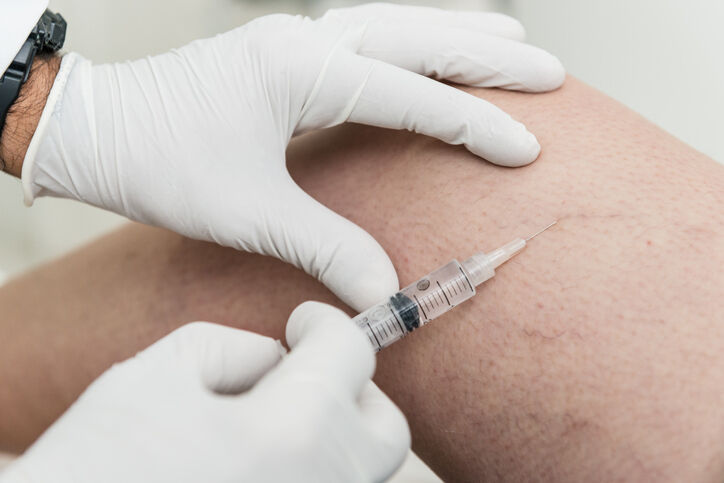
Does Sclerotherapy Hurt?
Are you considering sclerotherapy? Learn more about this standard varicose vein treatment:

Varicose vein ablation and sclerotherapy involve slightly different methods to eliminate bulging veins. Here’s what you need to know about each procedure.
In the past decade, advancements in varicose vein treatments have replaced lengthy, invasive procedures to eliminate painful, unsightly bulging veins. Instead, patients can now treat varicose veins with a brief outpatient procedure. Two of the most common techniques used today are thermal ablation and sclerotherapy.
Each involves using slightly different methods to destroy a diseased vein. A vein specialist can determine which treatment is best suited for your needs. But in the meantime, you can learn what to expect from each one with our guide below.
Both methods have been proven highly successful in treating varicose veins, with sclerotherapy eliminating varicose veins in 80 to 90 percent of cases and ablation showing an 85.9 percent success rate after one year of treatment. A board-certified vascular physician safely performs each.
Before either treatment, your vein specialist will receive detailed images of your veins from an ultrasound exam. You don’t need to take any special precautions before the appointment. However, your doctor may advise you to stop taking certain medications. Here’s what you can expect from sclerotherapy and vein ablation:
Sclerotherapy. Sclerotherapy is recommended for smaller varicose veins and spider veins. The doctor will inject a saline-based sclerosant into the vein to irritate and scar the vein walls, forcing it to close. You may feel a stinging sensation during the procedure as the needle goes into the vein. The doctor will apply pressure to the vein to ensure the solution seals the veins. Once the vein collapses, it can no longer carry blood. The blood will divert to nearby healthy veins.
Slight bruising and minor discomfort around the site are common after-effects but usually resolve in a few days. Over-the-counter medications can reduce any pain. Although extremely rare, an allergic reaction to the sclerosant is possible. Depending on the number of veins needing treatment, you may need more than one sclerotherapy session.
Vein Ablation. Varicose vein ablation refers to treatments using heat from either a laser or high-frequency radio waves to eliminate the varicose vein. Larger varicose veins are best treated with thermal ablation.
To begin the minimally invasive procedure, the doctor will apply a local anesthetic that numbs the area around the vein. After a tiny incision is made, a catheter is inserted into the vein. Then, a thin fiber placed in the catheter emits bursts of heat to destroy the diseased vein. Because the incision is so minor, you won’t need stitches.
As with sclerotherapy, you may see slight bruising that should fade in a few days.
Although minimal anesthesia is used, it’s recommended that someone drive you home. You can resume your normal activities with a few restrictions, such as wearing compression stockings to promote healing and avoiding strenuous activities. Your doctor may also encourage you to walk as much as possible to promote healthy blood flow. Keep any follow-up appointments so your doctor can check on your progress.
While ablation and sclerotherapy are popular vein treatments, they are not the only ones. Modern varicose vein therapy has expanded to include these minimally invasive innovations:
VenaSeal: A proprietary medical adhesive seals the vein shut. No anesthesia is needed.
ClariVein. The doctor injects a sclerosing agent into the vein using a tiny rotating tip.
Ambulatory phlebectomy. The varicose vein is removed via two tiny incisions in the leg. Once the procedure is completed, you’ll only need a Band-Aid over the incision.
Talk to your vein specialist to explore the best treatment for your needs. With any of these procedures, you’ll eliminate the pain and unsightly appearance of varicose veins in no time!
Are you thinking about seeking treatment for your varicose veins? Center for Vein Restoration (CVR) has three convenient locations around Phoenix, Arizona! Each office is led by a board-certified physician with years of experience performing vein ablation, sclerotherapy, and more.
Khanh Q. Nguyen, DO, RPVI, has been in practice for almost two decades and is the Corporate Medical Director for Center for Vein Restoration.
Soohyun Kim, MD, RVT, brings her expertise as a vascular surgeon to treat every stage of vein disease.
Contact their offices today for a consultation or to speak to a representative. You may also schedule online at your convenience.
Don't live near an Arizona CVR vein clinic location? No problem! With over 100 vein clinic locations in 22 states and the District of Columbia, there's sure to be a CVR vein center near you.
3509 S. Mercy Road, Suite 101
Gilbert, AZ 85297
1500 S. Dobson Road, Suite 310
Mesa, AZ 85202
9515 W. Camelback Road
Suite 108
Phoenix, AZ 85037